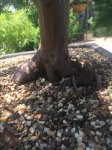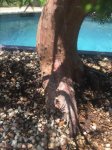markyscott
Imperial Masterpiece
And when is the next time you'll see him? I'm going out at the end of August.
He'll be in Houston end of July. I'll check my august schedule. Maybe I'll make a trip out there.
And when is the next time you'll see him? I'm going out at the end of August.
There's no reason you can't use a board with Juniper, but the goal of the Ebihara method is to build the "dinner plate" or "pancake" nebari. Juniper doesn't do that.Marky,
Can this be used for juniper? I know nebari isn't necessary for conferious but great trunks are always great trunks.
Also, the illustration from the first page has the board barely below soil level whereas you place yours on top of drainage level?
There's no reason you can't use a board with Juniper, but the goal of the Ebihara method is to build the "dinner plate" or "pancake" nebari. Juniper doesn't do that.
Bury the board 2 or 3 inches under soil to get the roots the thicken.
But, really, this is for Maples and Elms and Zelkova.


I plan to do this method with my crape myrtle, I think it will work wonders with a crape too.this is for Maples and Elms and Zelkova.
Yes, it will! They do it on their own.I plan to do this method with my crape myrtle, I think it will work wonders with a crape too.
No problem if your maple is healthy. Do it in the spring as you have described using smaller screw. Of course there is greater risk of causing more damage, but a little splitting should be fine.Can you accomplish this technique with a smaller 1 year old cutting of a maple? The only thing that scares me is the use of the screw on something as young as what I have. Trunk is about 1/2'' in diameter already. It's growing fast this year. I assume I could just reduce the size of the screw, but would something as small as what I am describing just split when the screw went in?
Can you accomplish this technique with a smaller 1 year old cutting of a maple? The only thing that scares me is the use of the screw on something as young as what I have. Trunk is about 1/2'' in diameter already. It's growing fast this year. I assume I could just reduce the size of the screw, but would something as small as what I am describing just split when the screw went in?
I'm doing it with my tulip poplar next year or the year after...Thanks. Going into a large grow pot to get that nebari started at a young age. I assume the earlier you can start it the easier building a strong nebari becomes.
What's your goal? It sounds as though your in the stage of building the trunk. Is that correct?
@markyscott That is correct. Building from the ground up, following the grow, chop, grow next step, chop, and on and on. Essentially the method Peter Adams outlines in his "Bonsai with Japanese Maples" Book.
Here's a thread I wrote on developing a trident using this technique.
https://www.bonsainut.com/threads/field-grown-trident.18131/
I grew it in the ground for several years before putting in in a grow pot. It's in a board in the pot, but was not when planted in the ground. I highly encourage you to develop the trunk in the ground. There are a number of resources to help you with this, particularly Brian Van Fleets blog and numerous posts and resources both here and on his own blog by Al Keppler (Smoke). Developing it in a pot will be significantly slower. You can put it on a board in the ground if you wish. I'd use the same technique- I've tried planting it on a tile before, but the roots grow down anyway and lift the trunk off the tile. I suggest you screw it down.
If it were me, I'd plant it in spring without a tile and let it grow two full seasons before chopping it back. I'd dig it up in spring, work the roots and plant it on a board at that time.
Scott
I have killed a few saplings about this size. The problem I encountered was not splitting, but that the screw provoked a CODIT damage response in the xylem about 2x or 3x the diameter of the screw. Death occurred because the roots were 'sealed off' by the natural compartmentalization around the screw. IOW, using a smaller screw on smaller (thinner) trees is important.Can you accomplish this technique with a smaller 1 year old cutting of a maple? The only thing that scares me is the use of the screw on something as young as what I have. Trunk is about 1/2'' in diameter already. It's growing fast this year. I assume I could just reduce the size of the screw, but would something as small as what I am describing just split when the screw went in?
I have killed a few saplings about this size. The problem I encountered was not splitting, but that the screw provoked a CODIT damage response in the xylem about 2x or 3x the diameter of the screw. Death occurred because the roots were 'sealed off' by the natural compartmentalization around the screw. IOW, using a smaller screw on smaller (thinner) trees is important.
@markyscott I totally wish that I could do that, but i am moving soon and don't know if I would be allowed to if I am in say, a townhome, or 2, if I will be moving in time to get it in the ground there.
When you say significantly slower, how much time does growing it in the ground save? Five years, ten years? I am completely okay with waiting a while longer. In Chicago, it gets frigidly cold in the winter. We consistently have at least three or four days below zero, and sometimes 10 to 20 below zero. Any risk with those temps and a trident?
I will definitely screw it down either way. And use nails on the roots when that time comes. I'll also be sure to check out both Brian and Als blogs to get a better understanding.
I autopsy every tree of mine that has died. I have not run tests, but that is certainly something you could do with the bit of insight I have provided from my experience with zelkova serrata.Have you tested for a ratio of screw size to diameter of trunk at the point the screw is inserted? BTW, that really makes sense, and I might not have thought of it. If the diameter, or size, of the compartmentalized area is too large, it wouldn't allow for enough nutrients to pass around it to the roots. Kind of like a heart attack in a person.
I autopsy every tree of mine that has died. I have not run tests, but that is certainly something you could do with the bit of insight I have provided from my experience with zelkova serrata.
Water and mineral nutrients are conducted up the tree in the xylem, so the CODIT response causes the tree to desiccate. Photosynthate to feed the tree as well as the roots is conducted down the tree in the phloem (inner bark) was unaffected by the damage response in the wood. IOW, you have the right notion but based on an erroneous model of how trees work.





